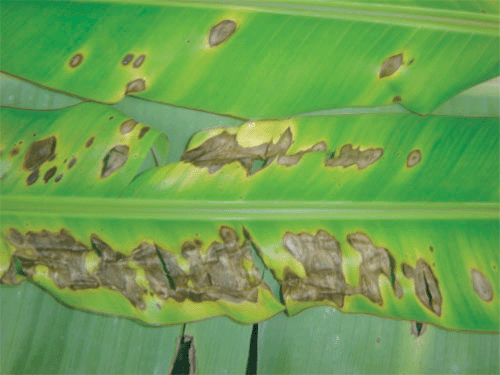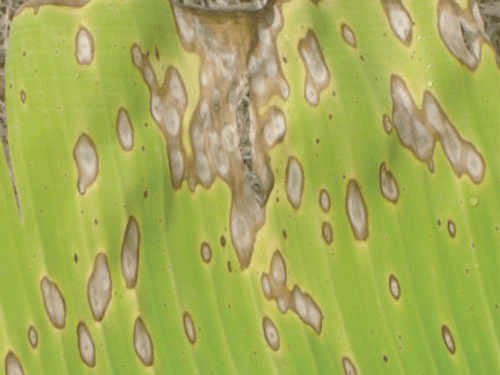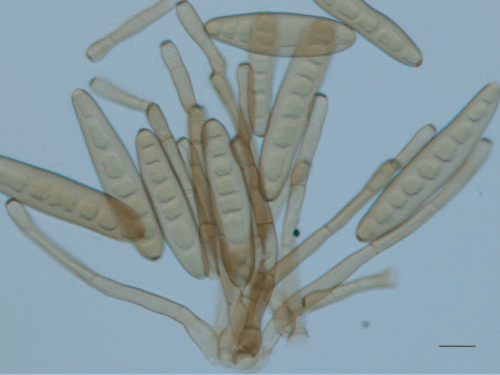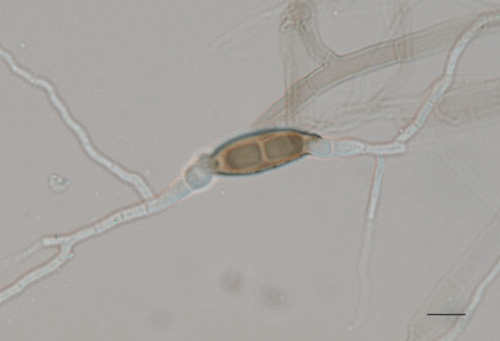First report of leaf spots on banana in Brazil caused by Bipolaris sacchari
M. Silva A , H. L. Mendonça A , R. W. Barreto A B and O. L. Pereira AA Departamento de Fitopatologia, Universidade Federal de Viçosa, Viçosa, M.G. 36570-000, Brazil.
B Corresponding author. Email: rbarreto@ufv.br
Australasian Plant Disease Notes 3(1) 10-11 https://doi.org/10.1071/DN08005
Submitted: 12 January 2008 Accepted: 25 January 2008 Published: 14 February 2008
Abstract
A new leaf spot disease caused by Bipolaris sacchari is reported for the first time on banana (Musa × paradisiaca).
Banana (Musa × paradisiaca) is among the 10 most important food crops in the world. Brazil is one of the largest producers of banana fruit, which is consumed mostly domestically and is only a minor export product. Bananas in Brazil have been threatened by the arrival in 1998 (Pereira et al. 1998) of Black Sigatoka, one of the worst diseases of banana. This disease is progressively spreading in Brazil. Parallel to this there has been an effort to distribute cultivating material of cultivars of bananas known to be resistant to Black Sigatoka by Federal and State agricultural organisations, including some EMBRAPA (Empresa Brasileira de Pesquisa Agropecuária) Research Centres, as a potential substitute for the popular, but highly susceptible traditional cultivars. The Yangambi Km 5 cultivar is resistant to Black Sigatoka and other diseases and is one of the cultivars that are currently being offered to growers. It is originally from East Africa and is being distributed in Brazil under the name cv. Caipira. Recently, samples of leaves of young plants of this cultivar, showing a severe leaf spot attack, were brought to the Plant Clinic at the Universidade Federal de Viçosa from a newly established plantation in the municipality of Tocantins (State of Minas Gerais, Brazil) for diagnosis. The disease and etiological agent are described below.
On young leaves, leaf spots were brown with concentric zonations and dark brown margins, surrounded by a chlorotic halo and a circular necrotic dark brown area at the centre (Fig. 1); on older leaves spots were elliptical, pale brown, necrotic, whitish to light grey, and centrally surrounded by brownish haloes that coalesce with age (Fig. 2).

|

|
A dematiaceous hyphomycete was regularly found associated with the leaf spots. Slides were prepared and mounted in lactophenol for observation under a light microscope (Olympus BX 60). Conidiophores were solitary or in small fascicles, cylindrical, 38–153 × 3–6 µm, 1–6 septate, dark brown and pale at the apex. Conidia were solitary, straight to somewhat curved, cylindrical to narrow ellipsoidal, 35–104 × 11–16 µm (most 66–70 × 14–15 µm) and 3–9 distoseptate (most 5–7), the first septum was median, brown, scars darkened, external and truncate, germ tubes apical and extending along the main axis of the conidia (Figs 3 and 4). This morphology fits well within that described for Bipolaris sacchari (E. Butler) Shoem. (Sivanesan 1987). This fungus has already been previously recorded in association with a banana disease, namely crown-rot of banana in the Virgin Islands (Wallbridge and Pinegar 1975). A sample was deposited at the local herbarium (Herbarium Universidade Federal de Viçosa, deposit number VIC 30534).

|

|
The fungus was isolated onto PDA plates, brought into pure culture and grown at 25°C for 7 days. Culture disks were taken from the border of the colonies and used to inoculate young healthy leaves of banana plants (cvv. Caipira, Prata Anã and Pacovã). These were then kept humid by wrapping in plastic bags and left for 48 h. After removal of the bags the leaves were observed daily for the emergence of disease symptoms. After 10 days, lesions similar to those observed in the field were seen only on plants of cv. Caipira. Bipolaris sacchari was sporulating on these lesions and the fungus was reisolated. B. sacchari is better known as an important sugarcane pathogen but is also known to be polyphagous, attacking several other monocots. In Brazil it had previously only been recorded on sugarcane. This is the first report of B. sacchari as a banana pathogen in Brazil (Mendes et al. 1998) and the first time it has been reported as causing leaf-spots on this crop.
Pereira JCR,
Gasparotto L,
Coelho AFS, Urben A
(1998) Ocorrência da sigatoka-negra no Brasil. Fitopatologia Brasileira 23, 295.

Sivanesan A
(1987) Graminicolous species of Bipolaris, Curvularia, Drechslera, Exserohilum and their teleomorphs. Mycological Papers 158, 1–261.

Wallbridge A, Pinegar JA
(1975) Fungi associated with crown-rot disease of bananas from St Lucia in the Windward islands. Transactions of the British Mycological Society 64, 247–254.



